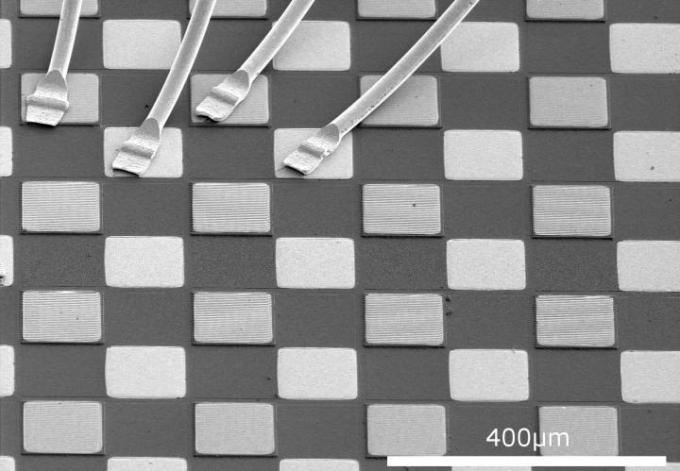Jul 27 2016
The primary source of infrared radiation is heat ¡ª the radiation produced by the thermal motion of charged particles in matter, including the motion of the atoms and molecules in an object. The higher the temperature of an object, the more its atoms and molecules vibrate, rotate, and twist through their vibrational modes, the more infrared radiation they radiate. Because infrared detectors can be ¡°blinded¡± by their own heat, high-quality infrared sensing and imaging devices are usually cooled down, sometimes to just a few degrees above absolute zero. Though they are very sensitive, the hardware required for cooling renders these instruments less-than-mobile, energy-inefficient and limits in-the-field applications.
 A quantum cascade detector is a high-speed detector composed of semiconductor devices that sense specific wavelengths of infrared light and convert that light into proportionate electrical signals. (CREDIT: Andreas Harrer)
A quantum cascade detector is a high-speed detector composed of semiconductor devices that sense specific wavelengths of infrared light and convert that light into proportionate electrical signals. (CREDIT: Andreas Harrer)
A paper published this week in the journal Optics Express, from The Optical Society (OSA), describes a new type of portable, field-friendly, mid-infrared detector that operates at room temperature. Room-temperature operation, notes Andreas Harrer of the TU-Wien Center for Micro- and Nanostructures, Austria and the first author of the paper, ¡°is essential for detectors to be energy-efficient enough for portable and handheld applications. We want to pave the way to an infrared-detection technology which is flexible in design and meets all requirements for compact integrated field-applicable detection systems.¡±
The type of instrument developed by Harrer and his colleagues is known as a quantum cascade detector, or QCD. A QCD is a high-speed detector composed of semiconductor devices that sense specific wavelengths of infrared light and convert that light into proportionate electrical signals. A unique aspect of the design described by Harrer and his colleagues is that it consists of an 8 x 8 array of some of the best performing QCDs. Peak response tuning is achieved by specifically adjusting the well and the barrier dimensions to a wavelength of 4.3 microns.
The number of pixels used in the QCD, Harrer says, can be easily scaled up. "The growth and processing technology used can be adapted and extended to larger array dimensions and smaller pixel sizes," he says. ¡°This is essential to achieve cost-effective high resolution imaging devices in the future.¡±
The 4.3-micron wavelength detected by the QCD elements represents one of the three narrow wavelengths at which CO2 molecules absorb infrared radiation. Future applications envisioned for the device is with ¡°unmanned search and rescue robots that detect disaster victims, for example, based on the CO2 content of their exhaled breath,¡± Harrer said.
The 4.3-micron wavelength also falls within the so-called mid-infrared regime, which is also referred to as the chemical ¡°fingerprint¡± region of the electromagnetic spectrum. The rotational-vibrational absorption spectra of many chemical compounds are found within this wavelength range. In other words, when molecules absorb infrared radiation that falls within this wavelength range, they excite these molecules to a higher state of vibration, wherein they rotate and vibrate in distinctive, characteristic patterns that imprint a characteristic ¡°fingerprint¡± in the mid-infrared spectrum that can be used to identify particular chemical species. This identification is highly specific, and will be enhanced through the use of these QCD arrays for hyperspectral imaging of chemical species. The potential for enhanced detection in remote sensing at 4.3 microns is promising with the spectrally narrowed QCDs described by Harrer and colleagues.
Paper: A. Harrer, B. Schwarz, S. Schuler, P. Reininger, A. Wirthm¨¹ller, H. Detz, D. MacFarland, T. Zederbauer, A. M. Andrews, M. Rothermund, H. Oppermann, W. Schrenk, and G. Strasser,
"4.3 ¦Ìm quantum cascade detector in pixel configuration," Opt. Express 24, 17041-17049 (2016). DOI: 10.1364/OE.24.017041.